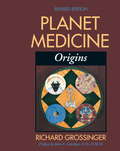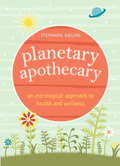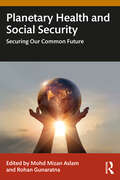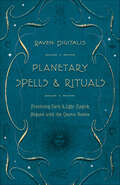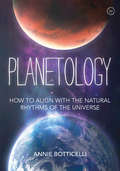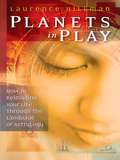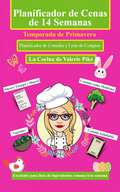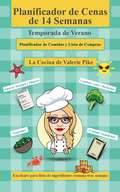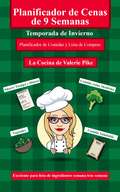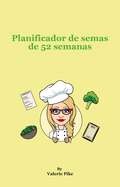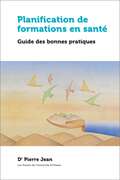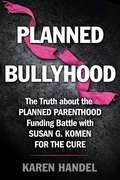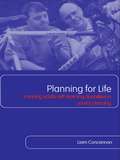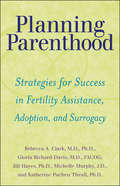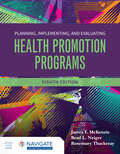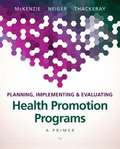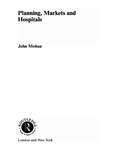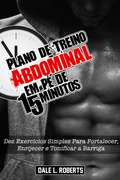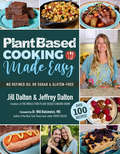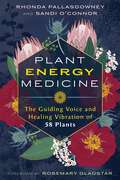- Table View
- List View
Planet Medicine: Origins, Revised Edition
by John E. Upledger Richard GrossingerPlanet Medicine is a major work by an anthropologist who looks at medicine in a broad context. In this edition, additions to this classic text include a section on Reiki, a comparison of types of palpation used in healing, updates on craniosacral therapy, and a means of understanding how different alternative medicines actually work. Illustrated throughout, this is the standard on the history, philosophy, and anthropology of this subject.
Planetary Apothecary
by Stephanie GailingThe Keys to Wellness Are Written in the Stars From impulsive Aries to balance-seeking Libra, methodical Virgo to sensitive Pisces, each astrological personality is distinct, with specific needs of body, mind, and spirit. In Planetary Apothecary, astrologer and nutritionist Stephanie Gailing offers a modern approach to the ancient healing art of medical astrology. You'll find wellness and lifestyle recommendations customized for your zodiac sign, including: * Health-Supporting Foods and Eating Tips * Spa and Wellness Therapies* Relaxation Practices* Yoga Poses * Aromatherapy* Natural Remedies* Flower Essences Filled with strategies and inspiration for nurturing body and soul, Planetary Apothecary brings the healing wisdom of the planets within reach to help you optimize your physical health and emotional well-being.From the Trade Paperback edition.
Planetary Health and Social Security: Securing Our Common Future
by Rohan GunaratnaOffering an in-depth exploration of the security challenges posed by COVID-19, Gunaratna, Aslam, and their contributors present a comprehensive collection of thematic and country-specific analyses on post-pandemic planetary health strategies. This book critically evaluates the global challenges and responses to COVID-19, examining its impact across key sectors such as security, defense, trade, health, economy, and religion. Through empirical evidence and diverse case studies, it analyzes the strengths and shortcomings of international efforts and offers thoughtful approaches and solutions to fostering a balanced and resilient planet for future generations. Essential for students and scholars of planetary health, international relations, humanitarian affairs, strategic and defense management, policy studies, and global health, this book also serves as a valuable resource for policymakers, government ministries, and agencies seeking insights into effective global practices.
Planetary Spells & Rituals: Practicing Dark & Light Magick Aligned with the Cosmic Bodies
by Raven DigitalisAn extension of every Witch's spirituality, spellcraft is a vital tool for sparking significant life change. And when you attune your magick to planetary energies, it becomes infinitely more powerful. Organized by the Sun, Moon, and planets, each of the 55 spells and rituals in this book are aligned according to astrological energies and designed to be easily customized for your specific intention and unique spiritual path. From personal growth to practical concerns, you'll find a rich variety of dark and light magickal workings for every purpose:GlamouryHealing childhood woundsRevealing truthHalting gossipAttracting loveMending quarrelsBanishing heartacheEnding addictionsCursing a violatorBreaking a curseCord-cuttingSummoning ancestorsGuiding the dead and dyingWeather magickProphetic dreamingScryingSpiritual rebirthPast-life regressionIncluded is a list of zodiacal and astrological correspondences—Sun sign, Moon sign, day of the week, mythical archetypes, themes, and more—to help you determine the best times to work magick.Praise: "Masterful and compassionate...Planetary Spells & Rituals provides food for thought, spells and rituals for use, and is a welcome, much-needed addition to any spellcaster's bookshelf."—Judika Illes, author of The Encyclopedia of 5,000 Spells"Planetary Spells & Rituals is an urban, modern, and cutting-edge manual for those willing to explore the layers of magickal possibility within. Raven expresses the essence of the Craft in a clear way, and balance is a great theme of this book. The framework of Planetary Spells is quite informative for those seeking some strong workings to bring forth realistic results."—Michael W. Ford, Author of Luciferian Witchcraft and The Bible of the Adversary"Unlike most spellbooks, which focus on the moon, Planetary Spells & Rituals places major importance on zodiacal and planetary influences, with the power of the sun playing a pivotal role. Eclectic and unusual spells are accompanied by sensible explanations of how spells work and how to cast them well. As always, Raven takes an old standard and makes it new and fresh, with a magickal approach all his own."—Deborah Blake, author of The Everyday Witch A to Z Spellbook and The Goddess is in the Details"With his usual depth, clarity, and highly readable style, Raven Digitalis reveals yet another layer we can add to our magic's efficacy and power—perfect timing! This, in addition to many creative and practical ideas for spellwork, renders Planetary Spells & Rituals a must-have for any Witchy library."—Thuri Calafia, author of Dedicant: A Witch's Circle of Fire"With great understanding Raven takes his readers into previously uncharted territory as Planetary Spells dives deep into the nuances of astrology, dark and light magick, and weaves together a unique and much-needed volume explaining the connections between them."—Corvis Nocturnum, author of Embracing the Darkness, Understanding Dark Subcultures, and Allure of the Vampire; Our Sexual Attraction to the Undead
Planetology: How to Align with the Natural Rhythms of the Universe
by Annie BotticelliThis is the first mainstream book to look at the whole range of astrological rhythms, including the planetary retrogrades and eclipses as well as the monthly moon cycle, in order to achieve success and a more contented and naturally flowing life.This is the first-ever mainstream guide to working with the astrological cycles of the Universe. It will allow you to plan ahead and achieve more success in your projects, by taking risks at certain times and avoiding them at others, and also enable you to live more fully and joyfully, flowing with the natural rhythms of life. Accessible to complete beginners as well as offering more complex insights to those who already practise astrology, Planetology is packed full of hands-on projects to help readers work with Mercury, Venus, Mars and the sun and moon, each project with three levels of increasingly complex tasks that are designed to draw readers up to mastery level. At the book's core is Annie Botticelli's ASTRO system, which enables readers to align with each planet's motion through: Awareness (projects to work with each planet); Strategy (how to plan ahead for each cycle); Techniques (exercises that range from tapping to mineral soaks and detoxes to mantras); Remedies (such as crystals and homeopathy, all tuned into the planet under discussion); and Openness to unexpected, perhaps unwanted outcomes brought to you by Divine plan. These techniques, such as prayer and meditation, allow you to be receptive to the great universal flow that supersedes any one planetary cycle.
Planets and Possibilities: Explore the Worlds Beyond Your Sun Sign
by Susan MillerAstrology is almost as old as mankind, and has helped countless people throughout the ages. And although knowing astrological basics can tell you a lot, a more in-depth look into this ancient art can reveal so much more.In Planets And Possibilities, certified astrologer Susan Miller, creator of the popular Web site Astrology Zone, shows you how astrology can help you envision new possibilities for your future, ones you may never have considered.You'll learn about the myths the Greeks and Romans attached to the twelve zodiac signs to explain their characteristics. As you read these stories, Susan Miller shows you how their interpretations can help you fully understand your sign and perhaps see yourself in a whole new way! She also shows you how every Sun sign has a guardian planet that strongly influences the personality of each person born under that sign. For example, Sagittarius is ruled by Jupiter, the planet of prosperity and good fortune, and contributes to the happy-go-lucky Sagittarian approach to life. What will your ruling planet say about you?In addition, Planets And Possibilities helps you:* learn which careers may be luckiest, most profitable, and fun for you * discover the best ways to handle your cash flow and the ideal way for you to get rich * be more fit by following the natural ten- dencies of both your personality and your body * find out more about your romantic side and how to attract the person right for you. Astrology can help you uncover your latent gifts, affirm your hunches, gain the courage to take risks,build your confidence,and seize opportunities. Astrology can also offer powerful insights into the personalities of the people around you. Live your life to the fullest! Investigate your untapped potential! Itis all possible with Planets And Possibilities. Author Biography: Susan Miller has been an internationally acclaimed astrologer for over twenty-five years. A member of several astrological organizations and the author of The Astrology Book of Days, she is a monthly contributor to the astrology column of Self, McCallis, and eCompanyNowmagazines.Susan also created AstrologyZone.go.com, an award-winning Web site that receives millions of page views each month. She has been profiled in the New York Times and has been a guest on ABC-TVis 20/20 and The View, and CBSis The Early Show. She is a regular on Fox Televisionis Good Day New York and on the WB11 morning news in New York City.
Planets in Play
by Laurence HillmanPlanets in Play is the first foundational book that lets the reader reimagine his or her inner life through the self-exploratory language of astrology. Author Laurence Hillman-a widely respected astrologer with a loyal following and a formidable online presence-reconnects the planets with the character traits given them by the ancients. Whether one accepts astrology as being "real," its language and concepts can go a long way toward helping us see the archetypes that play on our lives. In observing the strengths, weaknesses, and character traits of each planet and zodiac sign, readers will receive a toolbox filled with instruments with which to newly understand their lives. The reader will then be able to make more conscious choices about how he or she is living out these different aspects. To that end, Hillman provides specific tactics and highly practical ideas of how to expressly nourish or minimize these tendencies through choice of behavior, lifestyle, and personal surroundings. Case examples, stories, and anecdotes run throughout the book to demonstrate and ease this process. In its appendices, Planets in Play provides a guide in how to get a quality astrological reading, with an emphasis on one's dominant archetypes. In addition, Hillman offers a basic grounding in astrology for those readers, therapists, or counselors who wish to learn how the ancient art works at a psychological level without necessarily committing themselves to its study.
Planificador de cenas de 14 semanas. Temporada de Primavera
by Valerie PikeMe gustaría presentarles el segundo libro de cocina de mi serie “Planificador de cenas 52 semanas”. La temporada de primavera, es para mí, la más adorable, tan colorida, tan inspiradora para nuevas ideas, para renacer, renovarse, solo un nuevo comienzo. Esta temporada va entre marzo y mayo. Así que vamos, celebremos con todas estas recetas deliciosas y fáciles de hacer. Incluí 14 semanas de recetas y sus listas de compras. Los pasillos en que he agrupado las listas de compras de ingredientes siguen a la tienda de comestibles de Ralph en mi ciudad natal. Otras tiendas de comestibles tendrán los artículos agrupados de manera similar. Compartiré con ustedes a lo largo de este libro, 169 recetas deliciosas y fáciles que han recopilado en mi experiencia sobre cocina saludable y todas vienen con su lista de compras. Así que manos a la obra a cocinar y disfrutar todas estas delicias con la familia.
Planificador de cenas de 14 semanas. Temporada de Verano
by Valerie PikeHola, como les ha ido con mis otros dos libros, les presento mi tercer libro de cocina de mi serie “Planificador de cenas para 52 semanas”. La temporada de verano, para mí se traduce en vacaciones, tiempo de calidad con la familia, compartir en la playa, lago o montaña, donde sea el lugar preferido de descanso y esparcimiento. Que mejor manera de disfrutarlo que preparar las deliciosas recetas que les introduzco en este libro. Esta temporada va entre junio y agosto. Así que vamos, celebremos con todas estas recetas deliciosas y fáciles de hacer. Incluí 14 semanas de recetas y sus listas de compras correspondientes. Los pasillos en que he agrupado las listas de compras de ingredientes siguen a la tienda de comestibles de Ralph en mi ciudad natal. Otras tiendas de comestibles tendrán los artículos agrupados de manera similar. Compartiré con ustedes a lo largo de este libro, 169 recetas deliciosas y fáciles que he recopilado en mi experiencia sobre cocina saludable y todas vienen con su lista de compras. Así que manos a la obra a cocinar y disfrutar todas estas delicias con la familia.
Planificador de cenas de 9 semanas. Temporada de Invierno
by Valerie PikeCon la experiencia que he adquirido en la cocina como chef y consultora personal a lo largo de mi vida tuve la idea de preparar este libro de acuerdo a las estaciones de mi país Estados Unidos como saben tiene una gran extensión, y los climas pueden variar mucho según la estación y la ubicación. He organizado mis recetas de cocina según cada temporada. En este primer libro de cocina inicio con la temporada de invierno, al comienzo del año calendario e incluye nueve semanas. Compartiré con ustedes a lo largo de este libro, 145 recetas deliciosas y fáciles que he recopilado en mi experiencia sobre cocina saludable, y todas vienen con su lista de compras. Así que manos a la obra a cocinar y disfrutar con la familia todas estas delicias. ¡Bon appetit!
Planificador de semas de 52 semanas
by Valerie PikePlanificador de comidas + Listas de compras La cocina de Valerie Pike en un año [Planificador de cenas de 52 semanas] Recetas familiares saludables con listas de la compra de un ama de casa preparada. La planificación de comidas se simplifica con comidas nutritivas. Su apretada agenda no le impedirá preparar comidas saludables con las sobras de los almuerzos. Elimine las conjeturas al planificar las comidas y coma de manera saludable con verduras, especias y verduras. En mis recetas se incluyen especias aromáticas como cúrcuma, jengibre, clavo, ajo, cebolla, cilantro, que reducen el dolor y la inflamación, así como muchas verduras de hoja verde oscuro. También he incluido especias picantes como chiles, mostaza, pimienta de Jamaica, jengibre, ajo, cebolla, pimienta de cayena y clavo de olor para condimentar alimentos saludables y acelerar su metabolismo en un 40 por ciento. ¡Mi planificador también tiene comida reconfortante para el gusto ocasional! ¡Un año de lista de ingredientes y recetas semana tras semana para planificar, ahorrar tiempo y dinero!
Planification de formations en santé: Guide des bonnes pratiques (Éducation)
by Pierre JeanConcevoir une activité de formation peut être intimidant ; réformer tout un programme d’études l’est d’autant plus. Voici un guide pratique de planification des apprentissages à l’intention des formateurs qui n’ont pas nécessairement une longue expérience dans le domaine. Principalement conçu pour les enseignants et les responsables de la formation des professionnels de la santé, ainsi que les professeurs universitaires, cet ouvrage propose une démarche qui peut servir à la planification de tout un programme d’études, une formation continue ou un stage. L’approche expérientielle est privilégiée et cinq études de cas en ont émergé, émanant du Canada et de pays émergents. Le langage est simple, évitant le jargon des experts en pédagogie. De plus, une série de tableaux récapitulatifs permet de s’y retrouver rapidement. Fondé sur les théories du changement et sur les principes de la planification systématique des apprentissages, ce guide, qui se veut pratique, est issu du monde médical mais est tout à fait pertinent pour les autres sciences de la santé et les autres disciplines professionnelles.Publié en français
Planned Bullyhood
by Karen HandelThe full, up-close story of the battle between Susan G. Komen for the Cure and Planned Parenthood from the woman at the center of the explosive media firestorm of early 2012, Karen Handel, former SVP of Public Policy at Komen.
Planning A Baby?: How to Prepare for a Healthy Pregnancy and Give Your Baby the Best Possible Start
by Dr Sarah BrewerPlanning a Baby? is all about giving your baby the best possible start in life. By taking maximum care of your health in the six important months before your new child is even conceived, you can optimise the chances of having a healthy baby. The first few weeks of gestation are critical. Research has shown that undernourishment during this time - often before the mother is even aware she is pregnant - can affect the baby a long way into the future. It is linked with the subsequent development of heart disease, high blood pressure and diabetes in middle age.In this completely updated and revised edition, Dr Sarah Brewer provides the latest groundbreaking research and gives advice on:-Contraceptive advances-Lifestyle and factors that affect early pregnancy-Conception itself - the myths and the facts-Which vitamins and minerals are needed, including the use of folic acid-Advice for vegetarians-Sperm health-An overview of the causes of miscarriageThis book aims to give potential parents all the tools they require before embarking on one of life's greatest adventures - conception, pregnancy and the birth of a healthy baby.
Planning For Life: Involving Adults with Learning Disabilities in Service Planning
by Liam ConcannonThis book traces the development of services for people with disabilities and discusses how much things have really changed for today's 'service users' since the days of asylums. It also assesses whether the policy of involvement, such as that outlined in Valuing People, is achievable in practice or simply places unrealistic burdens on professionals and service users.Based on findings from original research and interviews, the author argues that involving people with learning disabilities in service planning is difficult to achieve successfully and is currently, to a large extent, tokenistic. This area of challenging practice and emotive debate is brought to life by the voices of service providers, carers and the service users themselves, and illustrates the realities of working with people with learning disabilities.Planning for Life is valuable and informative for students of social work, social care and social policy, and will be enlightening reading for those working with adults with learning disabilities, in policy and in practice.
Planning For Uncertainty: Living Wills and Other Advance Directives for You and Your Family (A Johns Hopkins Press Health Book)
by William Reichel David John DoukasA practical guide to documenting your decisions and preferences in case of incapacitating illness.It won’t happen to me.I’m too busy to worry about a living will.My family will know what to do.No one wants to plan for incapacitating illness or death. But to spare loved ones from needless emotional suffering, or even legal battles, people of all ages need to document and communicate clear decisions about the final details of their lives while they are healthy and have time to fully consider their own values and preferences.Here, Drs. David Doukas and William Reichel help individuals make decisions and communicate their wishes to health care providers and family members and other loved ones. They use a question-and-answer format to guide readers through the process—emphasizing the crucial connection between values and treatment preferences. They explain advance directives and the health care decision-making process, including the values history, family covenants, proxies, and proxy negation. The appendix includes resources and web links for learning about advance directive requirements and obtaining legal forms in all fifty states.This practical guide helps people navigate the intimidating but important process of thinking about, and planning for, an uncertain future.
Planning Parenthood: Strategies for Success in Fertility Assistance, Adoption, and Surrogacy
by Michelle Murphy Jill Hayes Rebecca A. Clark Gloria Richard-Davis Katherine Pucheu TheallPlanning to become a parent is a profound experience, at times agonizing, hopeful, stressful, and joyous. Not everyone is able to become pregnant, however. When the journey to parenthood proves challenging, Planning Parenthood will guide prospective parents through the complicated mazes of assisted reproduction and adoption.Specialist authors first describe fertility assistance, surrogacy, and adoption, clearly outlining the requirements of each strategy. They compare the medical, emotional, financial, and legal investments and risks involved with each of these options. Then they introduce the issues that people will need to consider when deciding which path to parenthood is best for them. Along the way these experts offer encouragement for changing course under any number of circumstances. Supporting the detailed information in this book are personal stories of the often long, winding, and emotional road to parenthood—from in vitro fertilization to egg donation to surrogacy to adoption. Armed with professional knowledge and inspired by the experiences of others who have gone before them, prospective parents will be informed and reassured by this unique resource.
Planning for Healthy Communities: Equitable Approaches (Health and the Built Environment)
by Joongsub KimThis book investigates multi-disciplinary approaches to addressing the health of disadvantaged communities through equitable community development systems (CDSs).The core concepts underlying the book are three dimensions of support infrastructure (people: human-centering; place: place-cultivating; and ecosystem: sustainable capitalization), leveraging several theories (community capital, social justice) from community development. This book is based on the results of a recent grassroots, citywide engagement-driven initiative in Detroit, and on best-practice case studies in Chicago, Indianapolis, Cleveland, Boston, Philadelphia, Minneapolis, Richmond, and Portland. The initiative’s significant outcomes include a consensus—bolstered by those case studies—on seven components deemed essential to an equitable system for community development. This book proposes that the CDS can enhance community health if at least the following requirements are met: (1) adoption of a community-vitality framework as a citywide shared narrative; (2) coordination across financial institutions to allocate funds equitably to underserved communities; and (3) implementation of system governance with stronger attention to resident voices.This book demonstrates that bottom-up CDSs can and should be leveraged to enhance the health of underserved communities and investigates how best to address the three requirements to make the equitable system-based approach work effectively in practice. The audience of community development and community health actors will learn from Detroit and the case studies—offering lessons for other cities facing similar issues—how to leverage equitable CDSs to promote healthy communities.
Planning in Health Promotion Work: An Empowerment Model
by Roar AmdamCommunity development, planning and partnerships have become important terms in health promotion but, up until now, debate around these concepts have been discussed more in planning science than in public health literature. Roar Amdam draws on theories and new empirical evidence from local, regional and international planning and public health in order to develop a new model for health promotion: empowerment planning. Much health promotion planning has focused on top-down approaches, and while efforts to be participative are made, it is often without having a clear understanding of how community empowerment can be accommodated within health promotion programs. Amdam’s innovative concept combines top-down and bottom-up approaches to enable people to take more responsibility for their own health and for individual and collective capacity building. Planning in Health Promotion Work is suitable for all students and researchers of health promotion and health planning and development, whilst the numerous applied examples make it an invaluable resource for policymakers and practitioners working in public health.
Planning, Implementing and Evaluating Health Promotion Programs with Navigate Advantage Access
by James F. McKenzie Rosemary Thackeray Brad L NeigerPlanning, Implementing, and Evaluating Health Promotion Programs, Eighth Edition provides students with a comprehensive overview of the practical and theoretical skills needed to plan, implement, and evaluate health promotion programs in a variety of settings. The Eighth Edition incorporates a straightforward, step-by-step format to make concepts clear and the full process of health promotion planning understandable. This edition features updated information throughout, including the most current Responsibilities, Competencies and Subcompetencies (NCHEC & SOPHE, 2020), the Code of Ethics for the Health Education Profession (CNHEO, 2020), a Report of the Joint Committee on Health Education and Promotion Terminology, and a new set of goals and objectives for the nation -- Healthy People 2030. Responsibilities and Competencies Boxes - Readers will find useful boxes that contain the responsibilities and competencies for health education specialists that are applicable to the content of the chapter, and are based on the latest data in the field.Review Questions - The questions at the end of each chapter reinforce the objectives and key terms presented in each chapter and allow readers to test their mastery of chapter content.Activities - Each chapter includes several activities that allow students to use their new knowledge and skills. The activities are presented in several formats, and often build on activities found in earlier chapters.Includes Navigate - Every new print copy includes 365-day access to Navigate Advantage which provides an interactive eBook, flashcards, web links, slides in PowerPoint format, and more. Written for undergraduate courses in Health Education, Promotion, and Planning. A valuable resource to guide students as they prepare to take either the Certified Health Education Specialist (CHES) or Master Certified Health Education Specialist (MCHES) exam. © 2023 | 480 pages
Planning, Implementing, and Evaluating Health Promotion Programs: A Primer
by James McKenzie Rosemary Thackeray Brad NeigerIt provides students with a comprehensive overview of the practical and theoretical skills needed to plan, implement, and evaluate health promotion programs in a variety of settings. The features updated information throughout, including the new Responsibilities and Competencies generated from the Health Education Specialist Practice Analysis–2015 (HESPA-2015), and reflects the latest trends in the field.
Planning, Markets and Hospitals
by John MohanImproving access to hospital services has been a goal of public policy in Britain for over seventy years, but the means by which this goal is to be attained have changed significantly over time. Drawing substantially on original research, lanning, Markets and Hospitals represents a systematic attempt to access the strengths and weaknesses of different forms of planning and coordination of hospital development.The period covered includes: services prior to 1948; wartime hospital policy; the successes and failures of the mixed economy of health care in the inter-war period; the national hospital plan of 1962 and ultimately the market based reforms of 1991 and the changes since.This book makes a fresh contribution to enduring debates about planning and regulation of health care, about the governance of welfare services and about the appropriate role for voluntary, commercial and charitable provision of services. It reinterprets previous histories of hospital policy and questions whether current policies will reconcile competing goals of equity and choice.
Plano de Treino Abdominal em Pé de 15 Minutos
by Makoto Yamamoto Dale L. RobertsPerca a barriguinha se exercitando por apenas 15 minutos! E se você pudesse perder entre cinco a dez vezes mais peso eliminando a gordura indesejada da barriga? E se eu disser que você não precisa se cansar com horas de exercícios só para perder pouco ou nenhum peso? E se você pudesse ter mais tempo no dia para ler, passar tempo com a família ou relaxar? Autor de doze livros renomadíssimos sobre saúde e fitness, Dale L. Roberts apresenta seu plano de treino com dez exercícios abdominais em pé que dura menos de 15 minutos. Após quase uma década desenvolvendo exercícios de qualidade que maximizam o tempo, Roberts responde à pergunta: quais são os segredos para se livrar da barriguinha sem ter que trabalhar incansavelmente por horas? Neste livro, você vai aprender: • a eliminar aquele pedaço de bolo ou aquela coxinha a mais no abdômen; • por que não é preciso rolar no chão para ter uma barriga tanquinho; • um programa abdominal de quinze minutos para realizar a qualquer hora, em qualquer lugar; • que não é preciso nenhum equipamento para fortalecer o core; • por que em pé é mais eficaz para a perda de gordura do que deitado; • dados científicos que mostram que ficar em pé aumenta a expectativa de vida; • várias outras dicas para obter o máximo de qualquer treino ou plano de exercícios; • exercícios abdominais rápidos para que você possa curtir a vida; • dicas e técnicas para aplicar na sua rotina de exercícios atual; • a ganhar uma oferta gratuita exclusiva: o relatório “As Dez Melhores Ferramentas de Fitness Para Obter mais Resultados no Menor Tempo”; • e muito mais! Não perca mais tempo; compre este livro agora e finalmente elimine essa gordura da barriga de uma vez por todas! Clique em “Comprar” agora no topo desta página!
Plant Based Cooking Made Easy: Over 100 Recipes
by Jill Dalton Jeffrey DaltonFrom the creators of the popular YouTube channel The Whole Food Plant Based Cooking Show comes this timely and comprehensive cookbook! Plant Based Cooking Made Easy features over 100 life-saving, whole food plant-based recipes that are gluten-free, refined sugar & oil free, low in sodium, and full of scrumptious flavors.Modern cutting-edge nutritional research has clearly identified the whole food plant-based diet as the single most potent force for recovering and sustaining human health. Only a diet rich in a wide variety of fresh fruits, vegetables, beans, mushrooms, nuts, berries, and seeds—and which is free of highly processed foods, laden with preservatives, refined oils, sugar, and salt—has the power to reverse many of the leading chronic diseases the world faces today, including heart disease, diabetes, obesity, high blood, autoimmune disorders, and more.Jeffrey and Jill Dalton share the story of their own 23 year journey to plant-based transformation, one which not only empowered them to reverse their chronic health issues but also inspired them to create The Whole Food Plant Based Cooking Show—and now this cookbook! Drawing on their many years of experience with plant-based cooking, they spell out in detail all the appliances and preparations needed to set up your own kitchen for plant-based success.With over 100 recipes based on the best available plant-based nutritional research, Plant Based Cooking Made Easy covers all the bases, offering wholesome takes on everything from common comfort foods like hot dogs, macaroni & cheese, pizza, waffles, brownies, and double stuff Oreo cake, to international favorites like massaman curry, West African peanut sauce, sweet potato flatbread, mushroom bourguignon, tikka masala, hummingbird cake and more.Learn to easily make tasty gluten-free breads, muffins, cakes, pies, and cookies as well as plant-based cheeses and ice creams, salad dressings, and hummus, all in the comfort of your own kitchen. And if you should happen to get stuck, each recipe has a corresponding step-by-step video, easily accessible with a QR code scanner on your mobile device.With this cookbook as your ultimate guide, it has never been easier to make the life-changing switch to a plant-based diet. Soon to become an essential cookbook in healthy kitchens around the world, Plant Based Cooking Made Easy is your key to finally finding your own path to better health.
Plant Energy Medicine: The Guiding Voice and Healing Vibration of 58 Plants
by Rhonda PallasDowney Sandi O'Connor• Presents in-depth teachings on 58 flowers, trees, and plants• Each write-up features a full-color close-up photo along with the plant&’s medicinal and flower essence traits, the voice of its flower, energetic impact on the chakras, and an affirmation• Also explores plant biofield energetics, how to use flower essences, and the sensory experience of connecting with a plantBy learning to listen quietly to flowers and plants, we can tune in to the inner teachings they have to offer us. Plants can not only heal us, but they can also teach us how to live a more joyful, healthy, and balanced life.Sharing the teachings they&’ve received through years of attentive listening to flowers, trees, and plants, Rhonda PallasDowney and Sandi O&’Connor explore how to deepen your personal experience with the world of plants and connect with their energies. They look at the life force energy of plants, their sensory systems, biofields and electromagnetic energy fields, and their growth from seed to root to stem to leaf to blossom. They offer insights into how to deepen your sensory experience of plants—including their taste, texture, and sounds—and they also teach you how to work with flower essences.Presenting in-depth teachings on 58 flowers, trees, and plants, the authors explore each plant&’s medicinal and flower essence traits, the voice of its flower, its insight, its energetic impact on the chakras, and an affirmation to help you embody the teachings of the plant. Each plant discussion also features full-color close-up photos by Rhonda PallasDowney that capture the energetic imprint and personality of the plant.
